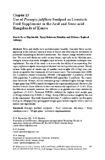| dc.contributor.author | Kipchirchir, K. Oscar | |
| dc.contributor.author | Kinuthia, Robinson N | |
| dc.contributor.author | Wahome, Raphael Githaiga | |
| dc.date.accessioned | 2014-02-19T07:11:46Z | |
| dc.date.available | 2014-02-19T07:11:46Z | |
| dc.date.issued | 2014 | |
| dc.identifier.citation | Kipchirchir KO, Kinuthia NR, Githaiga WR. "Use of Prosopis juliflora Seedpod as Livestock Feed Supplement in the Arid and Semi-arid Rangelands of Kenya.". In: Science, Policy and Politics of Modern Agricultural System . Netherlands: Springer ; 2014. | en_US |
| dc.identifier.uri | http://link.springer.com/chapter/10.1007%2F978-94-007-7957-0_13 | |
| dc.identifier.uri | http://download.springer.com/static/pdf/562/chp%253A10.1007%252F978-94-007-7957-0_13.pdf?auth66=1392966076_3ee52dcc8a52d6a6e16d10f28be79799&ext=.pdf | |
| dc.identifier.uri | http://hdl.handle.net/11295/64622 | |
| dc.description.abstract | Trees and shrubs have provided many benefits. Currently these are disappearing in the arid and semi-arid areas of Kenya and affecting the livelihoods of pastoralist depending on livestock production. The climate change will affect it further. The trees and shrubs are under serious threat, especially in the Sahelian zone, owing to increased periodic droughts, rapid increase of population leading to overexploitation. The aim of the study is to assess the feasibility of incorporating Prosopis juliflora seedpods into a typical dryland livestock production system. Twenty weaner Galla goats of similar age (6 months) and weights (11–14 kg) were randomly assigned to four treatments of five weaners each. The treatments were PJP0- No P. juliflora (control treatment), PJP100- (100 g/goat/day P. juliflora), PJP200 (200 g/goat/day P. juliflora), and PJP400 (400 g/goat/day P. juliflora). The experiment lasted for 70 days. All the treatment groups exhibited higher average weekly weight gains than PJP0 (control) throughout the experimental period. However, for the first 3 weeks, these differences were not statistically significant (P < 0.05). From the fifth week onwards, however, the differences in growth rates were statistically significant (P < 0.05). Treatment PJP200 exhibited the highest total weight gain (3.96 kg), followed by PJP400 (2.70 kg). Group PJP0 had lowest weight by the end of the experiment. This study demonstrated that P. juliflora could be used as goats feed up to 200 g/goat/day giving good weight gains and no negative effects on feed intakes and digestibility. | en_US |
| dc.language.iso | en | en_US |
| dc.publisher | University of Nairobi | en_US |
| dc.title | Use of Prosopis juliflora Seedpod as Livestock Feed Supplement in the Arid and Semi-arid Rangelands of Kenya | en_US |
| dc.type | Article | en_US |


